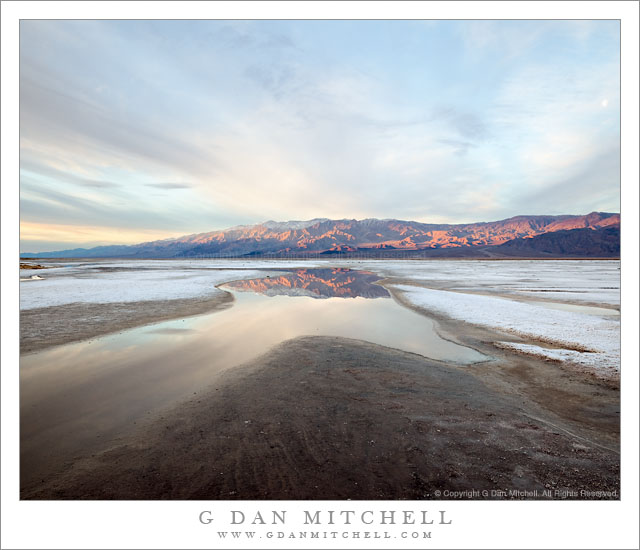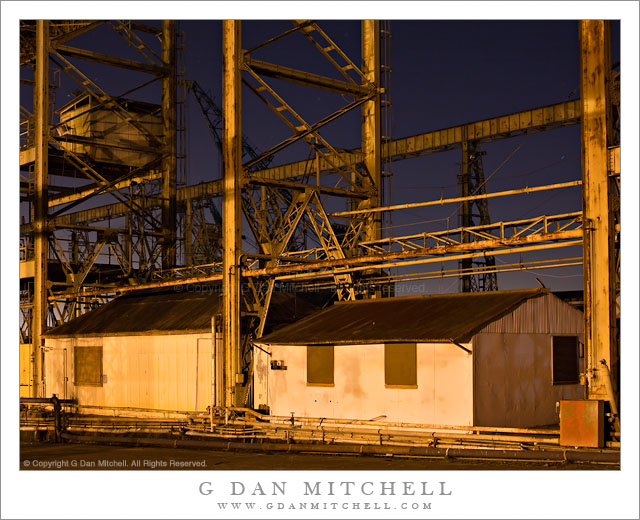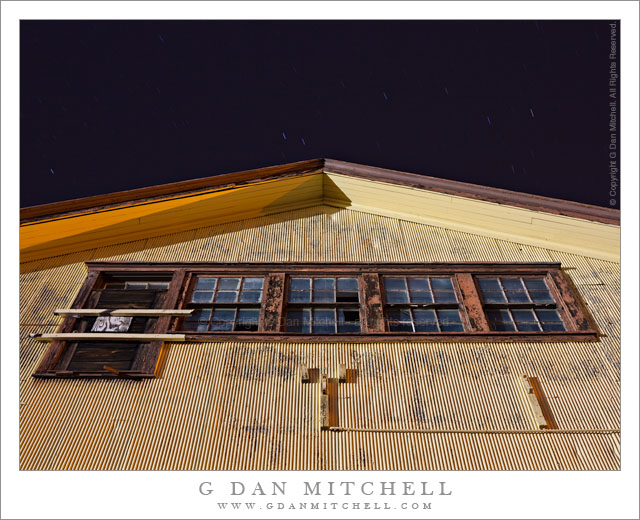
Yellow Buildings, Shadows, Moving Clouds. Mare Island Naval Ship Yard, California. February 26, 2011. © Copyright G Dan Mitchell – all rights reserved.
Night photograph of two large yellow buildings, shadows, and streaks for clouds moving across the sky above the Mare Island Naval Ship Yard, California.
This seems to be the week for photographs that result from a combination of preparation and serendipity. I made an attempt to photograph these specific buildings a year or so ago. I was not successful, and I managed to get spooked and learn a little lesson in the process. Most of the time night photography at Mare Island, and at many other places, is an incredibly quiet and peaceful and slow experience. There are often very few other people about, and in the darkness you can believe that you are entirely alone. Much of the work is done very slowly – wandering around looking for compositions in the near darkness first, and then patiently (or not so patiently!) waiting for long exposures to complete, sometimes more than once. On that first try here I had set up in an abandoned parking lot next to these buildings on a very quiet evening and was standing quietly by my tripod when I heard the sound of a car moving a somewhat fast. A sixth sense told me to pay attention… and a moment later a car came speeding around the corner of a near by building and into the parking lot! I don’t think I’ve ever grabbed my gear and run so fast! (The resulting photo is sort of funny and captures my panicked escape after perhaps 2/3 of the exposure had completed – the image of the buildings is there, but superimposed on it is a wild pattern of light formed as I spun around carrying the camera without even taking time to close the shutter.)
However, since then I have wanted to try shooting these buildings again. Late in the evening of this most recent shoot I noticed that some translucent clouds were passing overhead. When such clouds are lit from below and have a chance to move during a long exposure they can form very interesting patterns. I quickly wandered over toward that same notorious parking lot… and this time found a safer spot on a raised sidewalk along the front of some buildings… which also gave me a better angle on the buildings. The clouds were moving away and to the right, so I had to work quickly to get set up and start exposures. The first one (not shown here) was a slightly wider shot. Then I thought about the zig-zagging angles and shapes of the buildings roof lines and corners and noticed that the same shapes were mirrored in the shadow cast by a nearby building. With this in mind I decided to try a tighter crop on the buildings, and I ended up with the photograph seen here.
 G Dan Mitchell is a California photographer and visual opportunist. His book, “California’s Fall Color: A Photographer’s Guide to Autumn in the Sierra” is available from Heyday Books and Amazon.
G Dan Mitchell is a California photographer and visual opportunist. His book, “California’s Fall Color: A Photographer’s Guide to Autumn in the Sierra” is available from Heyday Books and Amazon.
Blog | About | Flickr | Twitter | Facebook | Google+ | LinkedIn | Email
All media © Copyright G Dan Mitchell and others as indicated. Any use requires advance permission from G Dan Mitchell.



